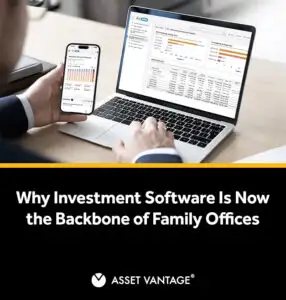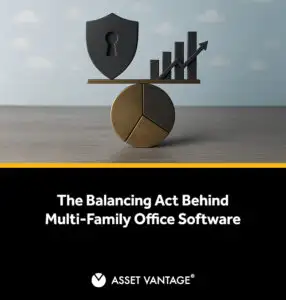Read Time13 Mins
- What Is a Family Office and Why Families Create Them
- Single vs Multi-Family Offices: Which Model Fits Your Wealth
- Minimum Net Worth Threshold for a Multi-Family Office
- How to Choose a Family Office
- Red Flags and Common Pitfalls to Avoid
What Is a Family Office and Why Families Create Them
A family office is a dedicated structure that manages a family’s financial affairs in one place. It goes beyond private banking by integrating wealth management, tax planning, and family governance under a single framework. The purpose is simple: preserve and grow the family’s wealth while keeping financial decisions aligned with the family’s values.
The Rockefeller family is often credited with creating the first modern single-family office in the nineteenth century. Today, that model has expanded globally, with single-family offices for ultra-wealthy households like the Waltons, and multi-family offices serving groups of families with shared infrastructure.
Core Family Office Services
- Investment management:
- Design and monitoring of family office portfolios
- Allocation across asset classes, including private equity, venture capital, hedge funds, and private investments
- Oversight of investment strategies to ensure a balance between growth and preservation
- Financial planning:
- Cash flow management
- Retirement and education planning
- Liquidity planning for major family needs
- Tax services:
- Complex tax planning and compliance across jurisdictions
- Structuring for efficiency and transparency
- Estate and succession planning:
- Wealth transfer via trusts and holding companies
- Frameworks for continuity and governance
- Risk management:
- Insurance audits and coverage
- Asset protection and regulatory compliance
- Concierge and lifestyle management:
- Bill payment, property oversight, travel, and other services
- Family governance and education:
- Creation of family charters
- Conflict resolution mechanisms
- Next-generation training and education programs
Why Family Members Turn to Dedicated Offices
Family members establish offices to protect, preserve, and grow wealth across generations. For many families, managing wealth through a bank or individual advisor eventually becomes insufficient. As portfolios grow and family structures expand, the need for a dedicated team becomes clear. The rationale is not only financial performance but also alignment of decisions with family priorities:
- Continuity: Ensuring the smooth transfer of assets to future generations.
- Control: Maintaining direct oversight of investments instead of outsourcing to external traditional funds.
- Customization: Designing investment strategies tailored to family needs, not generic benchmarks.
- Resilience: Embedding governance structures that reduce disputes and prevent value erosion.
For example, European families such as the Pictets in Switzerland or the Rockefellers in the U.S. have built offices that not only manage wealth but also act as strategic hubs for direct investments and global partnerships.
For wealthy families, the family office is the cornerstone of long-term resilience. It is less about chasing quarterly returns and more about growing wealth while protecting legacy. A family office is not an administrative luxury. It is the operating system that preserves capital, enforces governance, and sustains legacy across generations.
Single vs Multi-Family Offices: Which Model Fits Your Wealth
The choice between a single-family office and multi-family offices depends on three factors: minimum net worth, the scale of the family’s wealth, and the level of personalized services that the family expects. Both structures manage a family’s financial affairs with discipline, but they differ in cost, complexity, and accessibility.
A single-family office is built for one family and usually requires a significant wealth of US$100–150 million or more. Families carry the expense of a dedicated team and infrastructure.
Multi-family offices spread costs by serving multiple families. This creates cost efficiency by pooling resources, allowing each family to benefit from lower individual expenses while still accessing institutional-grade family office services.
Single-family Office: Focus on One Family’s Wealth
A single-family office serves only one family. It is often chosen when the net worth is too complex for banks or advisors and when privacy is critical.
- Exclusive focus: The office manages the entire family’s financial affairs in alignment with the family’s values.
- Highly personalized services: Every element of investment management, estate planning, and reporting is tailored.
- Complete control: Families decide on investment strategy, reporting style, and staffing of financial advisors and investment professionals.
- Costs: Building a full-fledged family office is expensive. Families must fund the systems, staff, and infrastructure of a dedicated team.
Multi-Family Office: Services for Multiple Families
Multi-family offices pool resources to deliver comprehensive financial services at a lower entry threshold than a dedicated family office. A multi-family office is a service model that caters to multiple families, offering a range of financial and personal management services with shared resources, often serving those who may not require or afford a private family office. They are especially attractive for affluent families and high-net-worth families that reach the minimum net worth threshold of US$25–50 million.
- Shared expertise: A team of financial advisors provides services such as tax planning, risk management, and concierge services to multiple clients.
- Cost efficiency: Fees are shared among several families, making access more affordable.
- Breadth of services: Families benefit from multi-family office services that include asset allocation, private equity, venture capital, and tailored investment strategies.
- Governance and education: Support often extends to family governance and next-generation training, ensuring continuity across multiple generations.
- Trade-offs: While families gain scale and cost efficiency, the level of personalized services may be less than what a single-family office can deliver.
Minimum Net Worth Threshold for a Multi-Family Office
Families often begin considering a multi-family office once their net worth reaches around US$25–50 million in investable assets. Below this level, private banking and individual advisors can usually manage the complexity. Beyond it, the benefits of pooled infrastructure, shared financial advisors, and professional governance outweigh costs.
A single-family office usually requires US$100 million or more because of higher running costs. According to the UBS Global Family Office Report 2023, the average family office manages US$1.1 billion in assets on behalf of client families, which illustrates the scale at which dedicated structures typically operate.
When Does a Family Office Make Sense?
- The family’s wealth is spread across multiple businesses, real estate, and private equity holdings.
- Multiple generations require structured succession planning and family governance.
- Consolidated financial planning, tax services, and risk management cannot be coordinated by a single advisor.
- Families want continuity of their family’s values, not just their assets.
Campden Wealth reports there are more than 7,000 family offices globally, managing an estimated US$6 trillion in assets (Campden Wealth, 2023). This growth reflects demand for unified structures once complexity rises.
When a Multi-Family Office Is the Right Model
Why it works:
- Creates cost efficiency by serving multiple families and sharing reporting infrastructure, technology, and dedicated teams of advisors.
- Grants access to comprehensive financial services, including investment management, concierge services, tax planning, and estate planning.
- Affluent families and high-net-worth families that want institutional-grade services without funding a full-fledged family office.
When a Single-Family Office Is the Right Model
Typical threshold: US $100–150 million or more in net worth.
Why it works:
- The family’s financial affairs are too large or complex to share with multiple clients.
- Provides highly personalized services, privacy, and complete control.
- Supports large investment portfolios and complex holdings across jurisdictions.
- Ultra high net worth families with complex global operations.
- Families that prioritize privacy and want a dedicated family office aligned only with their needs.
A single-family office typically costs US$1–2 million annually to run, making it efficient only when wealth crosses the US$100 million+ threshold (RBC Wealth Management, 2024).
| Factor | Multi-family Office (MFO) | Single-family Office (SFO) |
|---|---|---|
| Typical threshold | ~ US$25–50 million in investable assets | ~ US$100–150 million or more in net worth |
| Cost efficiency | Costs are shared across multiple families | Family bears the full cost of staff, systems, and infrastructure |
| Services provided | Access to comprehensive financial services (tax, risk, concierge, investment management) | Full control over services, often highly specialized |
| Best suited for | Affluent families or high-net-worth families are not ready to fund a full operation | Ultra high net worth families seeking privacy and control |
| Personalization | High, but sometimes less than a dedicated office | Fully highly personalized services tailored to one family |
| Team structure | Shared pool of financial advisors and specialists | Dedicated team serving only one family |
Why a Dedicated Team Matters at Scale
The UBS Global Family Office Report 2023 found that families with integrated teams reduced operational inefficiencies and reported better decision-making across multiple generations (UBS, 2023).
Key Factors in Deciding on a Multi-Family Office
Families should evaluate:
- Scale of wealth – whether the minimum net worth justifies the cost.
- Family members involved – more members increase reporting and governance needs.
- Services required – from tax services to concierge services.
- Investment strategy – complex or alternative investments often demand professional oversight.
Costs and Fee Structures Explained
Multi-family offices charge either asset-based fees or flat fees. Cost efficiency improves when several families share financial advisors, technology, and reporting infrastructure.
Multi-family offices typically follow three models:
| Fee Structure | Details | Best For |
|---|---|---|
| Asset-based Fees | 0.25%–1.00% of assets under management | Families aligning fees with portfolio growth |
| Flat Retainer | Fixed annual fee based on services provided | Families wanting predictable costs |
| Hybrid Model | Mix of asset-based and flat retainer fees | Families with diverse service needs |
Campden Wealth’s 2024 report shows that average operating costs for smaller family offices (< US$500 m AUM) were US$1.8 million annually, compared with US$8.7 million for offices managing over US$1 billion (Campden Wealth, 2024). This demonstrates the economies of scale that multi-family offices can provide.
How to Choose a Family Office
- Traditional family office: A single-family office serving one family, typically viable once wealth exceeds US $100 million. Offers full control and a dedicated team, but at a higher cost.
- Multi-family office: A shared platform serving multiple clients and several families, often suitable for US$25–50 million upward. Provides access to comprehensive financial services such as investment management, tax planning, and estate planning, with greater cost efficiency.
- Outsourced family office: Families contract specialists to handle selected functions like reporting, wealth management services, or tax and estate planning, without building a permanent structure.
Key Criteria for Selecting the Right Office Model
- Asset-based fees tied to AUM (0.25–1%)
- Flat retainers linked to services provided
- Hybrid models combining both
Different models offer different levels of customization.
- Multi-family offices deliver comprehensive financial services at scale, balancing breadth with cost efficiency.
- Single-family offices deliver highly personalized services, with every aspect of the family’s financial affairs tailored to one family.
- Tax planning and tax services
- Estate planning and succession planning
- Family governance and next-gen education
This breadth ensures all aspects of the family’s wealth and the family’s values are preserved.
Questions to Ask During the Evaluation Process
- What is your approach to building and monitoring investment portfolios?
- How do you manage asset allocation, exposure to private equity, venture capital, and alternatives?
- What frameworks do you use for risk management and risk tolerance across client families?
Fee Structure and Transparency
Families should evaluate:
- How is your fee structure designed?
- Which services provided are included in the base model, and what might be billed separately (for example, legal services or concierge services)?
- Do you benchmark fees against other family offices in the market?
- What level of personalized services can our family expect?
- How will our family’s financial affairs be managed daily, and who will serve as our point of contact?
- Do we receive direct access to a dedicated team of financial advisors and investment professionals?
- How do you handle tax planning, tax services, and compliance across jurisdictions?
- What is your process for estate planning and succession planning?
- Do you integrate tax and estate planning technology to improve reporting and accuracy?
- What experience do you have serving multiple families with similar complexity and goals?
- Can you provide references from other wealthy families or affluent families you currently serve?
- How do you balance the needs of several families without diluting quality?
- How do you address family dynamics, family governance, and the family’s values in your service model?
- Do you run programs that prepare the next generation for responsibility?
- How do you handle philanthropy and impact investing requests?
- What concierge services and lifestyle management support are available?
- Do these include travel planning, household accounting, or management of luxury assets?
- Are such services part of the base package or billed separately?
Red Flags and Common Pitfalls to Avoid
- Which services are provided included in the base agreement
- How costs are calculated for additional support, such as concierge services or legal services
- Whether asset-based, flat, or hybrid models are applied consistently
- The office cannot show experience managing diversified investment portfolios.
- There is little evidence of risk controls tailored to the family’s risk tolerance and investment objectives.
- Structures that protect the family’s values
- Conflict resolution mechanisms
- Clear roadmaps for next-generation leadership
- Over-reliance on generic templates for reporting or planning
- Limited willingness to adapt to unique family dynamics or philanthropic goals
- Emphasis on short-term gains without regard for stability
- Misalignment between capital preservation, growth, or balanced strategies and the family’s stated investment objectives
- Provide only basic compliance instead of strategic structuring
- Lack integration between tax services and estate structures
- Fail to coordinate with outside advisors for complex family’s wealth planning
What Families Gain From Joining a Multi-Family Office
Investment Management and Portfolio Oversight
- Asset allocation across equities, bonds, private equity, venture capital, and hedge funds.
- Integrated risk management tailored to objectives and risk tolerance.
- Access to private investments, direct deals, and co-investments through networks of investment professionals.
Financial Planning for Long-Term Security
- Household accounting, property management, and bill payments
- Travel planning and luxury asset oversight for yachts, estates, and aircraft
- Customized services designed to match individual preferences of family members
Lifestyle Management and Concierge Services
MFOs go beyond finance by offering concierge services and lifestyle management tailored to family members.
- Household accounting, bill payments, and property management
- Travel planning and luxury asset oversight for estates, yachts, or aircraft
- Custom services that adapt to each family’s unique lifestyle
Governance and Next-Gen Education
- Written family charters defining governance and decision-making.
- Conflict resolution processes that protect harmony across client families.
- Next-generation education in investment management and stewardship of the family’s values.
The Future of Multi-Family Office Services
The UBS Global Family Office Report 2023 noted that 67% of family offices expect to increase their use of technology, while 44% anticipate outsourcing more functions to keep costs predictable (UBS, 2023).
Outsourced Family Office Options
- Cost control: Shared reporting and administration lower costs compared to a single-family office.
- Access to specialists: Families gain financial advisors, tax experts, and governance professionals without hiring in-house.
- Flexibility: Outsourcing allows scaling of services provided as the family’s wealth grows.
- Wealth management services that integrate consolidated reporting, investment dashboards, and financial data visualization.
- Tax and estate planning platforms that streamline compliance and automate jurisdictional rules.
- Tools that ensure sensitive data remains protected while improving collaboration with external legal services and auditors.
What Families Should Watch
- Balance between outsourcing and control: Too much outsourcing may create dependency, while too little raises costs.
- Integration of private banking and technology: Offices that combine digital solutions with advisory may outperform.
- Alignment with long-term needs: As families grow in size and wealth, flexibility in wealth management and governance becomes critical.







